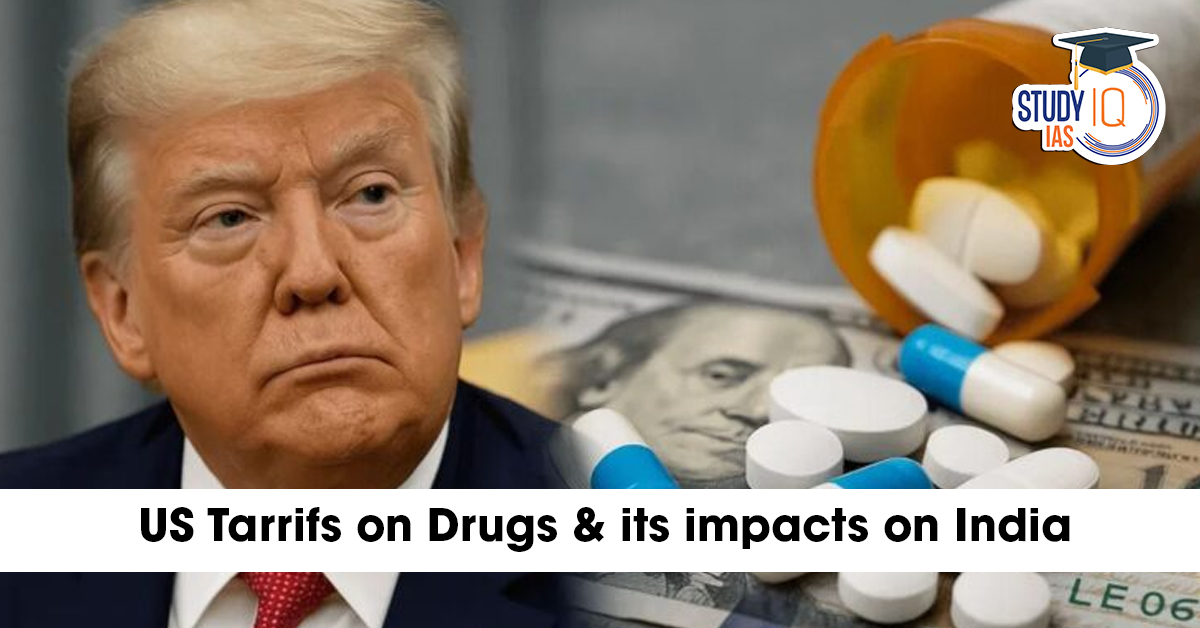Table of Contents
The United States and India share a deeply interlinked pharmaceutical trade relationship. The US is the largest importer of Indian generic medicines, which are valued worldwide for their affordability and quality. However, recent discussions around imposing 100% tariffs on certain drug categories have raised questions about the future of India’s pharma exports. While most Indian generic exports are currently exempt, the development has wider strategic, economic, and policy implications that India must navigate carefully.
Understanding the US Tariff Move
The proposed 100% tariff is largely aimed at reducing dependency on countries like China for critical pharmaceutical imports. The move is part of broader trade protectionism and attempts to strengthen domestic manufacturing in the US. However, there has been concern that such measures could indirectly affect other exporters, including India.
Key Facts:
-
The tariff targets drug imports under specific HS codes.
-
Indian generic drugs, which dominate the US market, largely fall outside the impacted categories.
-
The tariff is seen more as a political and strategic statement than a direct trade blow to India.
Why the US Market Matters to India
The United States is the largest destination for India’s pharmaceutical exports, accounting for over one-third of the $24+ billion India exports annually.
Major Advantages India Holds:
-
Dominance in generics (especially off-patent medications)
-
Cost-effective production
-
Compliance with USFDA standards
-
Strong presence in complex generics and injectables
Indian companies such as Sun Pharma, Dr. Reddy’s, Lupin, Cipla, and Aurobindo Pharma have established strong footholds in the American market, through exports, subsidiaries, and contract manufacturing.
Immediate Impact: Minimal but Not Ignorable
Currently, the 100% import tariff does not apply to most Indian generic drugs, making the immediate impact negligible. The Indian pharma sector continues exporting off-patent medicines to the US uninterrupted.
However, experts warn that India must remain strategically alert for the following reasons:
-
Policy changes can tighten in the future
-
Tariffs could expand to include APIs and finished formulations
-
Shifts in US domestic manufacturing policies may alter market access
-
Regulatory pressure may increase under the “Buy American” push
Risks & Challenges for India
Even if the present tariff impact is limited, India’s pharma sector faces structural vulnerabilities that could magnify risks over time.
1. API Dependency on China
India imports 70–80% of its Active Pharmaceutical Ingredients (APIs) from China. If US policy shifts target the entire supply chain, India could face indirect tariff burdens due to dependency.
2. Rising Compliance Costs
Indian firms must meet consistently high standards of USFDA compliance, adding to expenses.
3. Possibility of Non-Tariff Barriers
Instead of tariffs, the US could:
-
Tighten regulatory norms
-
Increase inspections
-
Restrict patent clearances
-
Encourage domestic substitutes
Strategic Response from India
To stay competitive and immune to future protectionist policies, India is focusing on:
Manufacturing Self-Reliance
Schemes like PLI (Production Linked Incentive) and Bulk Drug Parks aim to reduce dependence on API imports.
Strengthening Supply Chain Resilience
Post-COVID, India is actively diversifying sourcing and production to ensure uninterrupted global drug supply.
Expanding Next-Gen Capabilities
Indian pharma companies are investing in:
-
Complex generics
-
Biosimilars
-
Peptides
-
CAR-T cell therapies
-
Biologics
These areas reduce vulnerability and enhance bargaining power in international markets.
Policy Advocacy and Documentation
Industry leaders stress the need for:
-
Clear documentation of tariff exemptions
-
Active engagement with US trade authorities
-
Lobbying through diplomatic and industry channels
Long-Term Opportunities for India
Despite tariff talks, the US still needs India:
-
Over 40% of generic drugs sold in the US are supplied by India
-
India ensures affordable access to critical medication
-
The US healthcare system relies on cost-efficient imports to control insurance and patient burden
If the US increases tariffs on drugs from other countries, India may even gain further market space by having exemptions for off-patent generics.
Conclusion
The 100% US tariff proposal is unlikely to hurt India’s pharmaceutical exports in the short term because most Indian exports fall under off-patent generic categories that are exempt. However, this development highlights the importance of preparedness, diversification, and policy-driven resilience. India’s focus must remain on:
-
Cost efficiency
-
Quality compliance
-
API self-reliance
-
Innovation in next-gen therapies
By prioritizing these areas, India can not only safeguard its current dominance in the US pharma market but also expand its global leadership in affordable healthcare.


 Cuban Gar Fish: Facts, Habitat, and Cons...
Cuban Gar Fish: Facts, Habitat, and Cons...
 AI and Personality Rights in 2025
AI and Personality Rights in 2025
 Commonwealth Games Host Cities (1930–2...
Commonwealth Games Host Cities (1930–2...

























